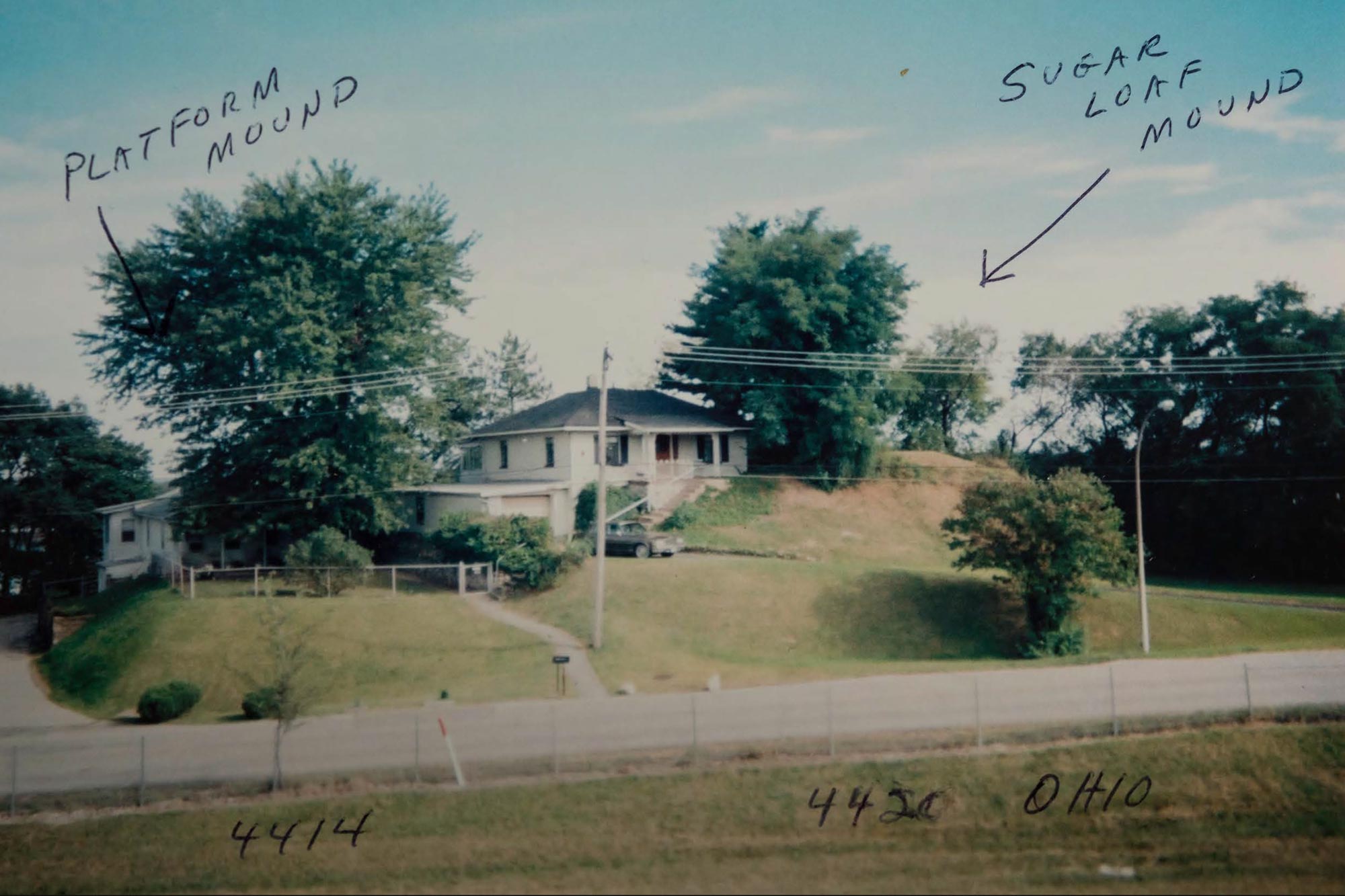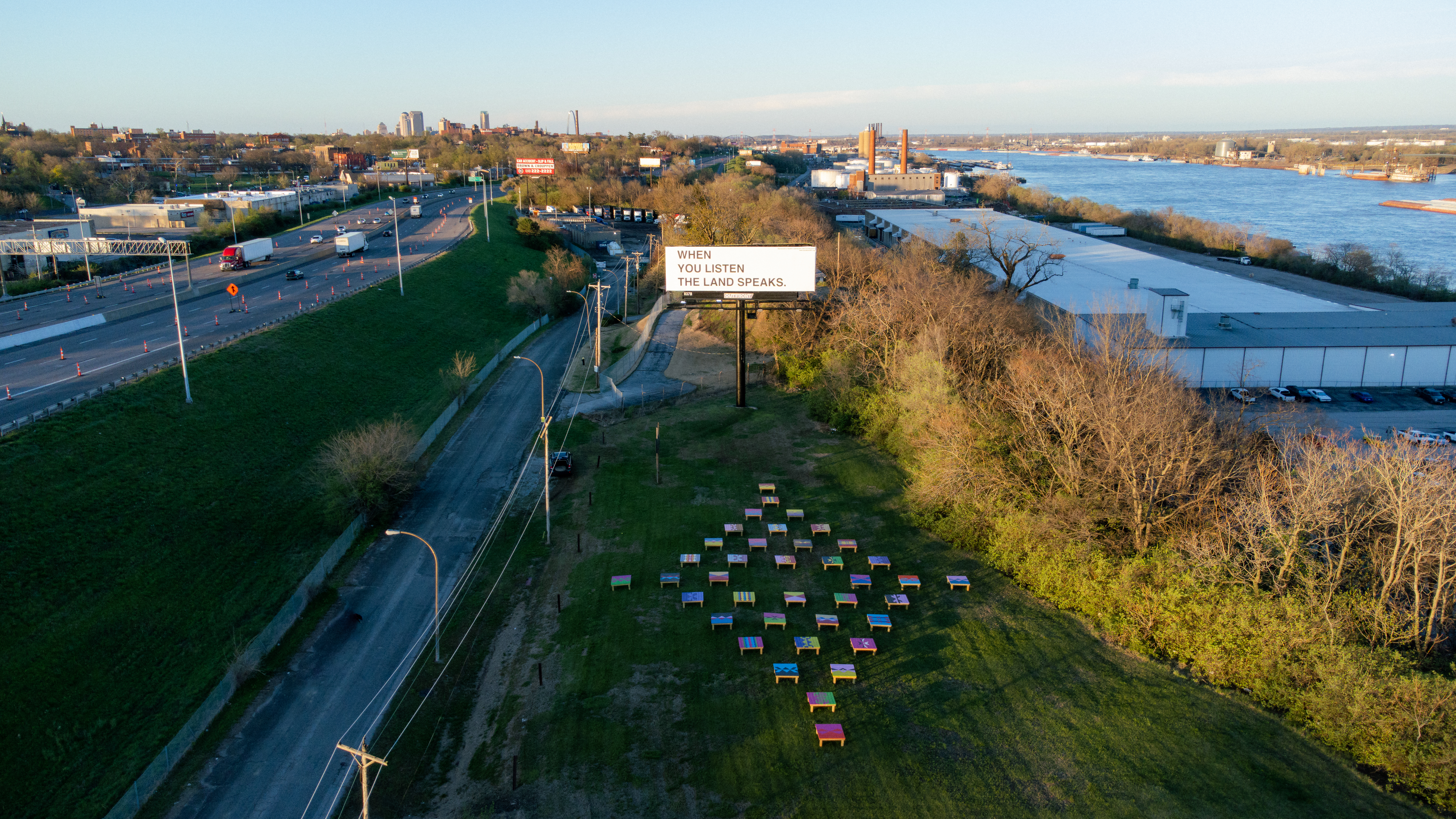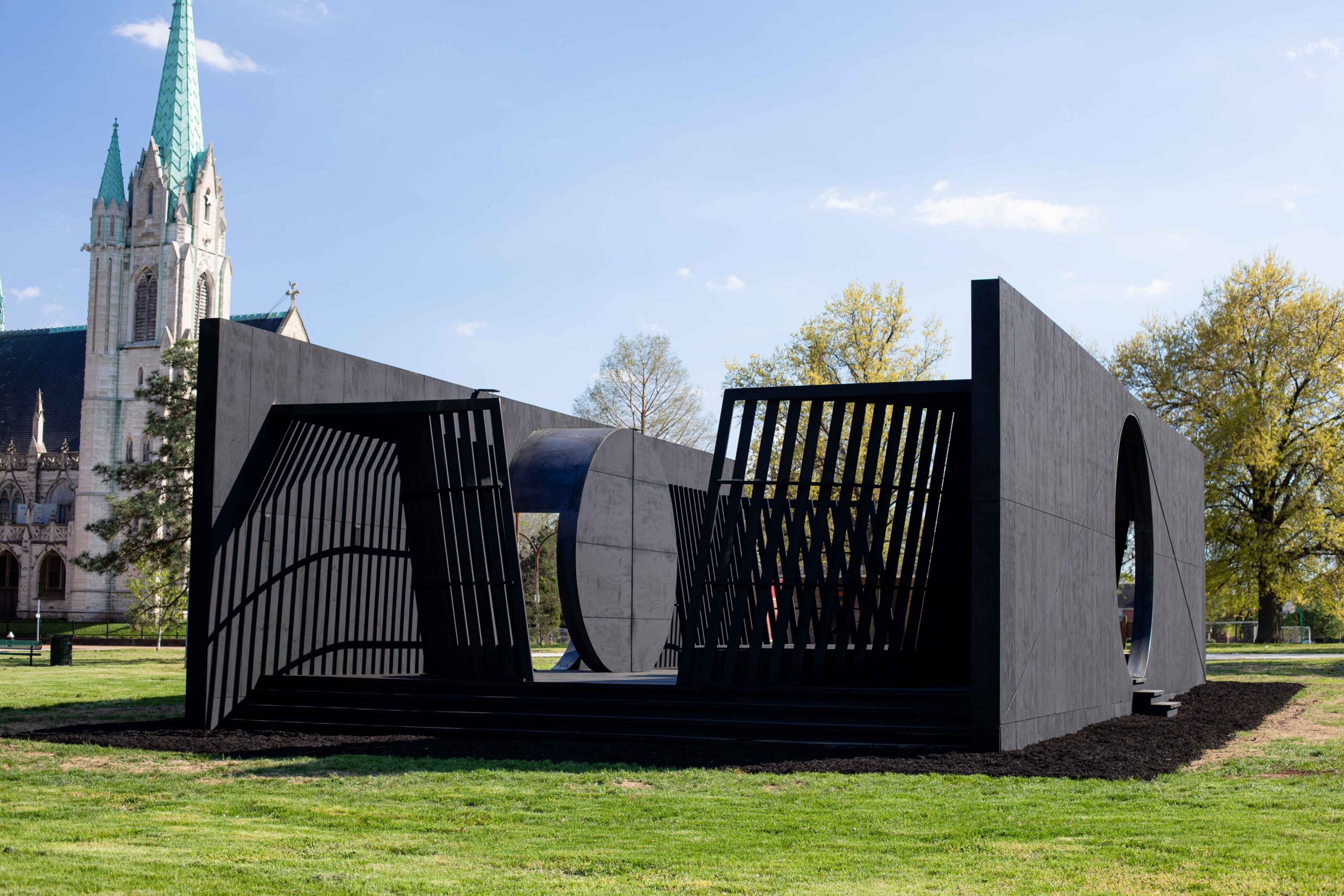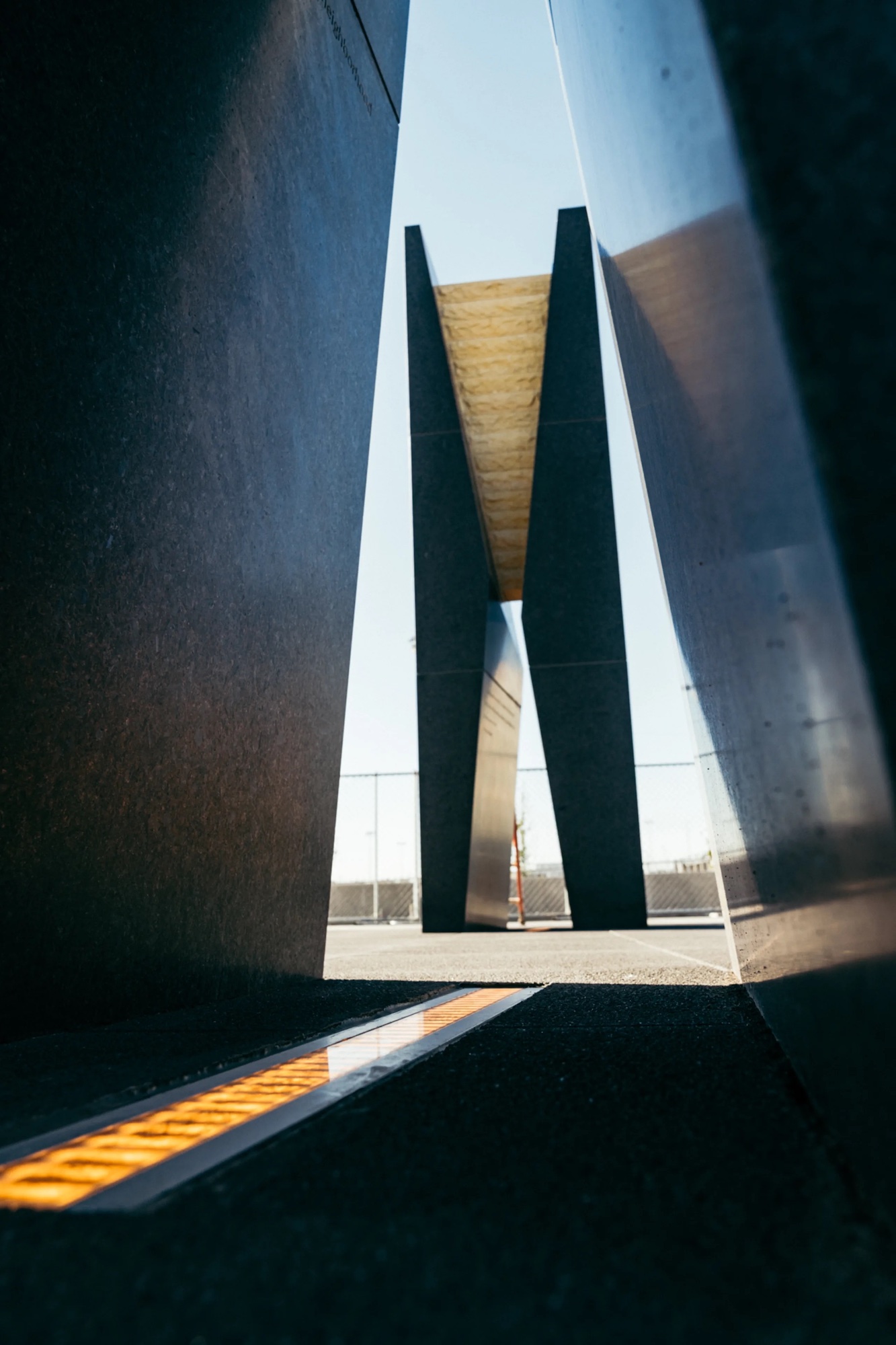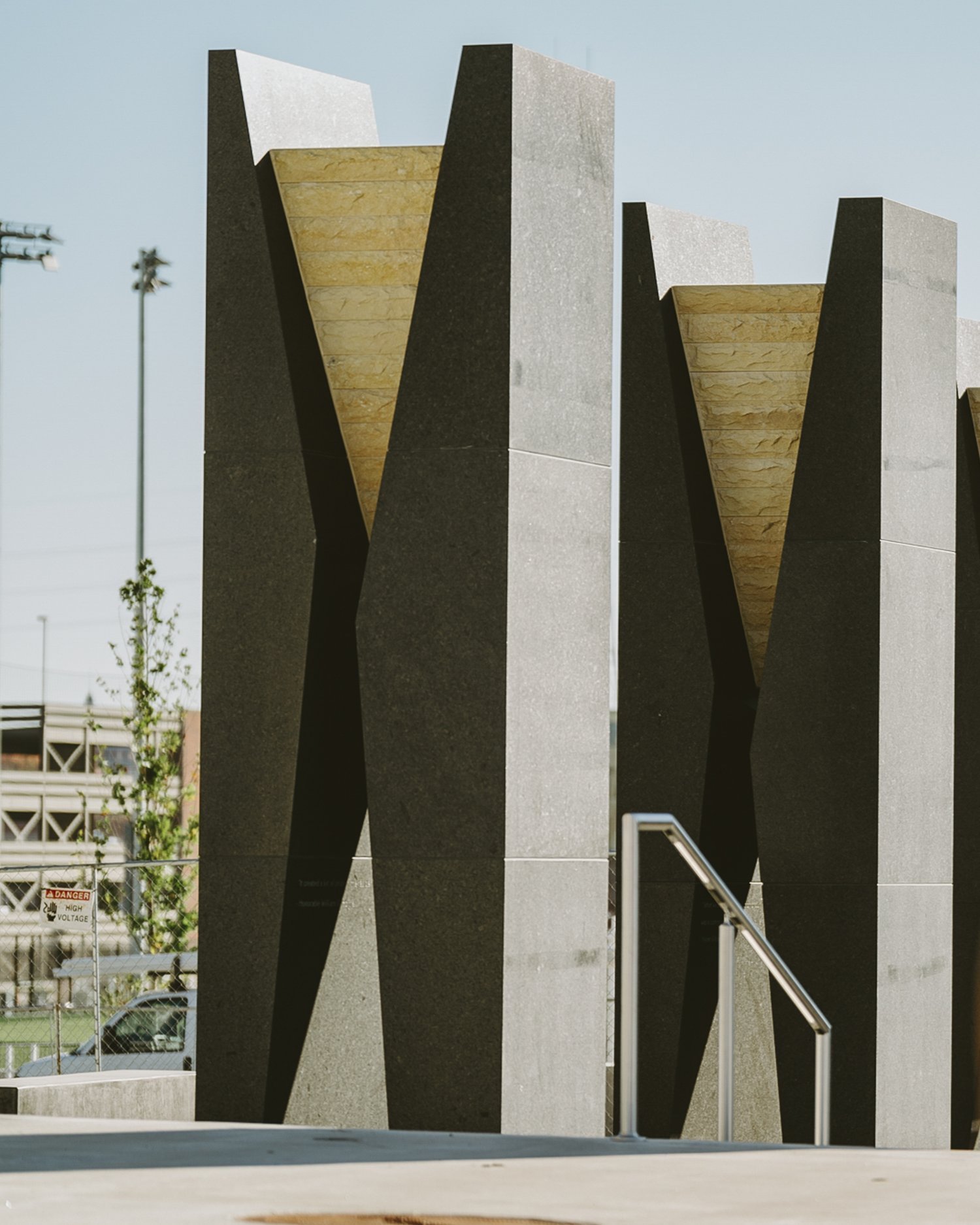Insisting on Resisting : Counterpublic 2023

New Red Order, Give it Back: Stage Theory, 2023, billboard at Sugarloaf Mound [courtesy of Counterpublic 2023, St. Louis]
Share:
St. Louis, home of the Gateway Arch at the confluence of the Missouri and Mississippi rivers. Emblem of Manifest Destiny. Nicknamed “Mound City” because of the number of earthworks built by Indigenous people before western expansion conspired to flatten them. Where caves beneath the city offered shelter to people using the Underground Railroad to escape enslavement. Where, in less than 20 years, residents of the historically Black neighborhoods of Mill Creek Valley and Pruitt-Igoe complex were displaced in the name of urban development and public safety. Where, in 2014, the Black Lives Matter movement coalesced. Current events reveal that in this city, this state, the sanctity of civil and human rights remains tenuous on every level. What role can a public art triennial play in such a troubled context, one that serves as a microcosm of forces at play across the United States?
In 2019, Counterpublic launched as a civic exhibition, testing its potential for community engagement in the Cherokee Street neighborhood, near The Luminary art space. ART PAPERS contributor Alexis Wilkinson describes projects that unfolded in a yoga studio, a panaderia, an auto body shop, a convenience store, breweries, and thrift stores, and she notes others that occupied vacant lots, streetlight banners, storefronts, and the garden of a Buddhist temple. She wrote, “Driving the triennial—as indicated by its name—is the urgent question of publics: what constitutes a public and how can alternative publics be formed?” She points to the “subtle, often tender, everyday activisms that reorient focus onto site and community, unexpected social exchanges, and the cultivation of new publics, catalyzed by each artistic gesture.”
Sugarloaf Mound from the Heckenberg Family Scrapbook [courtesy of Joan Heckenberg and Counterpublic 2023, St. Louis]
To prepare for the 2023 exhibition, the triennial’s home team committed to a year of listening sessions with a range of public constituents. A community report integrated into the exhibition catalogue outlines local interest in holistic community engagement with public memory, commemoration, and acknowledgement; repatriation/rematriation of Indigenous land; and reparative futures, among other concerns.
This time, Counterpublic begins to navigate the city’s turbulent history by deploying artworks that suggest ways to reverse the crushing flow of progress, and by presenting projects that deepen and widen the visibility and agency of vulnerable communities in St. Louis. The 2023 exhibition takes a bolder stance. It occupies more territory—six miles’ worth, running north and south—and dives into local culture and history in neighborhoods situated along the Jefferson Avenue corridor. Thoughtfully orchestrating three months of site–sensitive public art and programming is clearly not the only desired outcome for artistic director James McAnally; curators Allison Glenn, Risa Puleo, Katherine Simóne Reynolds, Diya Vij; members of New Red Order; and the 30 artists and collectives they invited to connect with local communities. Together, they aim to spark and elevate greater civic awareness, ownership, and activism by envisioning horizons of possibility beyond the now.
Counterpublic 2023, installation view, 2023 [photo: Chris Bauer; courtesy of Counterpublic 2023, St. Louis]
The southernmost coordinates of Counterpublic are 38°34′30″N 90°13′52″W, where the triennial spotlights Sugarloaf Mound, the sole remaining Mississippian earthwork in St. Louis. A set of projects around this site honors the Osage Nation’s rematriation and preservation efforts. Curator Risa Puleo invited Osage artists Anita and Nokosse Fields to create WayBack, a gathering space and a meditative soundscape in the field at the foot of the mound. A billboard that towers above the site makes public pronouncements. On one side, New Red Order invokes the group’s ongoing Give it Back campaign, part of an effort to restore Indigenous land throughout the United States. On the other side, artist Anna Tsouhlarakis shares one example of The Native Guide Project: STL, reminding visitors that “WHEN YOU LISTEN THE LAND SPEAKS.”
Farther north on the triennial path, Puleo worked with Pulitzer Prize–winning composer, musician, and artist Raven Chacon to bring the anti-monument Music for 13 Paths to Benton Park, which opposes the great arch with a community performance and installation of 13 hand-cut and tuned chimes suspended between two trees on the park’s tallest hill. At the southwestern corner of CITYPARK stadium, artistic director James McAnally invited local artist Damon Davis to realize the first Pillars of the Valley, the artist’s homage to the Black community of Mill Creek Valley, which was displaced to develop stadium and an adjacent entertainment complex. In coming years, the work’s granite and limestone pillars are to be installed along one mile of the Brickline Greenway on Market Street. Etched onto each pillar are quotes from former Mill Creek Valley residents who remember the history of their erased neighborhood. McAnally brought New York–based artist Torkwase Dyson to St. Louis, to enable her realization of Bird and Lava (Scott Joplin), an immersive architectural installation in St. Louis Place Park—a public sound space that resonates with the history of ragtime. Curator Diya Vij champions the regenerative art of Midwesterner Jordan Weber, whose collaborative Defensive Landscape seeks to establish a sustainable rainwater garden in Peace Park—positing environmental remediation as an element of life-sustaining community infrastructure.
Curator Allison Glenn’s proposition for St. Louis Place, a small neighborhood in the northeast corner of the city, illuminates The Griot Museum of Black History and its surrounding community with performative and installation projects that reanimate the once thriving neighborhood. Expressing the 2023 triennial gestalt, Glenn observes that The Griot’s logo is a bird looking backward, the Adinkra symbol of the word Sankofa, which symbolizes the belief that one must know the past to overcome the future. “Go back and get it,” Glenn writes in the catalogue, “is a perfect sentiment by which to reconsider space, site, and the environment … tuning into the historical threads that bridge this contemporary moment with those that came before.”
Torkwase Dyson, Bird and Lava (Scott Joplin), 2023 [photo: Chris Bauer; courtesy of Counterpublic 2023, St. Louis]
Glenn invited Ghanaian–born and –based architect David Adjaye to create his first-ever permanent public art project in St. Louis. Listening to Glenn in conversation with Adjaye conveys the force of his imagination. In a roomful of locals and visitors gathered at The Griot, the visionary thinker talked about the ideas behind this project. Asaase III is now under construction. The curving hybrid earth form will consist of recycled and upcycled topsoil, limestone, and bricks from demolished and abandoned buildings, to be completed in public view during the three months of Counterpublic.
Adjaye is globally renowned for his landmark architectural projects, including the Smithsonian National Museum of African American Culture and History in Washington, DC. His recent forays into sculpture counter the encoded narrative that earthworks are primitive forms. He posits that earth is “the most resourceful and the most sustainable material, and it’s the most abundant material on the planet …. It’s the one material that, when left in its natural state, cleans the air.” At once infrastructural and terrestrial, Asaase III is expected to harden and strengthen over time, becoming a geological form integral to the community’s future.
Damon Davis, Pillars of the Valley, 2023 [courtesy of Counterpublic 2023 and St. Louis CITY SC]
Damon Davis, Pillars of the Valley, 2023 [courtesy of Counterpublic 2023 and St. Louis CITY SC]
As Adjaye says, “This work is not a sculpture, like a bronze, that is going to sit on a pedestal. It is not on a plinth. It is an invitation to walk the geometry and the dimension of this building, to be able to look at it differently …. It’s a device—it’s a Trojan horse—to invite you to come and be here and to engage with this community and to engage with this place.” Asaase III’s permanent placement defies recurring land grabs in this city and insists on resisting further displacement of the local Black community. The project embodies Counterpublic’s emerging capacity for engagement with publics who are essential to healing and rebuilding the cultural architecture of St. Louis.
Cathy Byrd is an independent curator, art writer, and oral historian skilled in the art of roving. Her nomadic practice amplifies today’s issues and ideas at the center and the fringe of cultural scenes around the world. Her curatorial work includes The Blue Dress Project, Potentially Harmful: The Art of American Censorship, Re\constructing Atlanta, Le Flash and Losing Yourself in the 21st Century. Her writing appears in Art in America, Public Art Review, and Sculpture, among other publications. The Fresh Art International audio podcast she launched in 2011 holds an archive of more than 300 conversations on contemporary creativity. Find her at FreshArtInternational.com and @freshartintl
